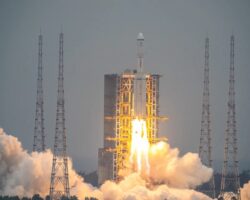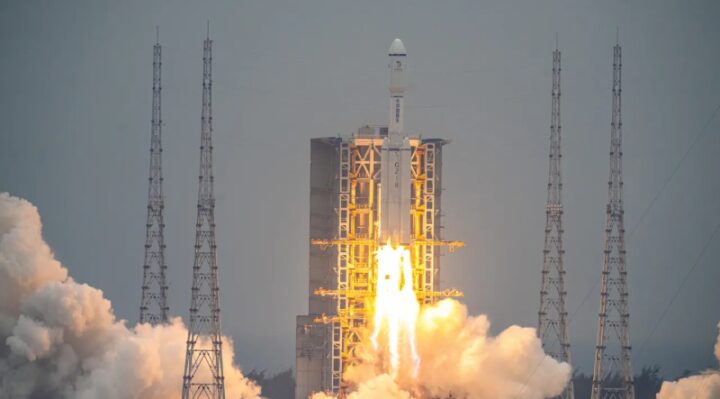A relay satellite supporting moon missions has been launched by China, Queqiao-2


Tuesday saw the launch of China’s Queqiao-2 relay satellite, which will aid future south polar and far side lunar missions.
Wenchang Satellite Launch Center saw the launch of a Long March 8 rocket at 8:31 p.m. Eastern time on March 19 (00:31 UTC on March 20). About 40 minutes after launch, the China National Space Administration (CNSA) verified that the Queqiao-2 satellite was traveling toward the moon.
According to CNSA, Queqiao-2 had completed the deployment of its solar arrays and was in its intended orbit, which had an apogee of 420,000 kilometers and a perigee of 200 kilometers.
The 1,200-kg satellite, which is a first step toward China’s 2030 lunar base construction plans, has a 4.2-meter parabolic antenna. It is part of China’s future lunar exploration plans.
When the spacecraft reaches the moon, it will enter a very elliptical lunar orbit that is inclined by 55 degrees. In order to help China’s Chang’e-6 lunar far side sample return mission, which is scheduled for launch in May, a specific orbit was created. Since Earth’s gravity has delayed the moon’s rotation throughout time, the far side of the moon is never facing the planet.
For the majority of its orbit, Queqiao-2 will be in direct sight of Earth and Chang’e-6, which is aimed for Apollo Crater in the far side’s southern hemisphere.
The purpose of these subsequent missions is to test in-situ resource utilization methods, such making bricks out of lunar regolith, and to find volatiles and possible resources on the moon. Precursors to the International Lunar Research Station (ILRS) are the missions.
In 2018, Queqiao-2, also known as “Magpie Bridge-2,” was introduced as a more able version of Queqiao. The Chang’e-4 mission-the first-ever lunar far side landing-was made possible by the previous satellite. Around 70,000 kilometers beyond the moon, in a halo orbit around the Earth-moon Lagrange point L2, the old Queqiao relay satellite is still in service.
X and UHF bands will be used by Queqiao-2 to connect with Chang’e spacecraft. It will communicate with Earth using the S and Ka bands. It has software that can be reconfigured and several data speeds.
Additionally, the spacecraft could help in the lunar endeavors of other nations. An official from DFH Satellite, a division of the China Aerospace Science and Technology Corporation (CASC), stated last year that “it is possible to provide relay communication services for other lunar landing exploration missions at the lunar south pole or lunar far side in the future, aside from providing relay support for future Chinese lunar missions.”
In addition, Queqiao-2 has payloads related to the Chang’e-7 mission’s science goals for 2026. These are an Earth-moon length baseline very long baseline interferometry (VLBI) experiment, an array neutral atom imager, and an extreme ultraviolet camera.
Tiandu-1 and Tiandu-2, two tiny experimental satellites, were also launched with the vehicle. These will perform navigation and communications technology verification tests while floating in formation in lunar orbit.
Satellite-to-ground laser ranging as well as intersatellite microwave ranging techniques will be tested. For the intended Queqiao lunar navigation and communication constellation, the satellites serve as a pathfinder.
China plans to launch approximately 100 times in 2024. The upper stage of the nation’s previous launch, which occurred last week, malfunctioned and failed to deliver two satellites to the moon.
It looks that the top stage is not quite at the moon, but rather in an extremely high high Earth orbit (HEO). Since a brief notification on the problem, China has not released any updates on the mission. If the mission can be saved is still up in the air.


